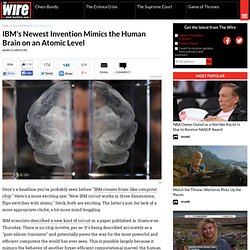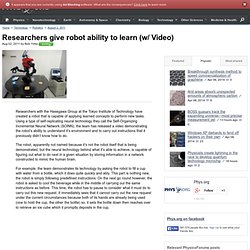

IBM unveils cognitive computing chips, combining digital ‘neurons’ and ‘synapses’ Cognitive computing chip (credit: IBM Research) IBM researchers unveiled today a new generation of experimental computer chips designed to emulate the brain’s abilities for perception, action and cognition.

In a sharp departure from traditional von Neumann computing concepts in designing and building computers, IBM’s first neurosynaptic computing chips recreate the phenomena between spiking neurons and synapses in biological systems, such as the brain, through advanced algorithms and silicon circuitry. The technology could yield many orders of magnitude less power consumption and space than used in today’s computers, the researchers say.
Its first two prototype chips have already been fabricated and are currently undergoing testing. Called cognitive computers, systems built with these chips won’t be programmed the same way traditional computers are today. Google Explains Quantum Computing in One Simple Video. Although we’ll have to wait to discover what innovations Google’s secret “X lab” holds for the future, the company does have at least one bleeding-edge venture it wants to unveil to the public right now. In partnership with NASA, Google has embarked on a project to use a 512-qubit D-Wave Two quantum computer to tackle some of our biggest computational problems. And because visuals often help explain complex concepts, Google has posted a short documentary explaining what quantum computing is, and how it plans to use the technology to make new discoveries.
First announced back in May, Google’s partnership with NASA will allow the two teams — along with several universities — to share the powerful computer, so they can research several different areas. This new computing dynamic gives scientists the ability to determine a variety of possible solutions simultaneously, saving energy and speeding up the computing process by many orders of magnitude.
Image: YouTube, Google. Freakishly realistic telemarketing robots are denying they're robots. The latter should be just a matter of time since it's likely caused by connection latency and processor time.

The former...don't give them ideas. Yeah, speech recognition is a processor intensive function. If they want to pay me to fix their system, I'll sign on - I think it would be fun. I'm not afraid of robots. I, for one, welcome our ... "I understand" used inappropriately. Wriggling worm is breakthrough for artificial life. IBM's Newest Invention Mimics the Human Brain on an Atomic Level - Adam Clark Estes. Here's a headline you've probably seen before: "IBM creates brain-like computer chip.

" Here's a more exciting one: "New IBM circuit works in three dimensions, flips switches with atoms. " Heck, both are exciting. The latter's just, for lack of a more appropriate cliché, a bit more mind-boggling. IBM scientists described a new kind of circuit in a paper published in Science on Thursday. There is no chip involve, per se. The new so-called nanofluidic circuit works a little bit like a network of streams.
Playfun Artificial Intelligence Can Play Video Games. Better Than Human: Why Robots Will — And Must — Take Our Jobs. Imagine that 7 out of 10 working Americans got fired tomorrow.

What would they all do? It’s hard to believe you’d have an economy at all if you gave pink slips to more than half the labor force. But that—in slow motion—is what the industrial revolution did to the workforce of the early 19th century. Two hundred years ago, 70 percent of American workers lived on the farm. Today automation has eliminated all but 1 percent of their jobs, replacing them (and their work animals) with machines.
It may be hard to believe, but before the end of this century, 70 percent of today’s occupations will likewise be replaced by automation. First, machines will consolidate their gains in already-automated industries. All the while, robots will continue their migration into white-collar work. And it has already begun. Click to Open Overlay Gallery Here’s why we’re at the inflection point: Machines are acquiring smarts. Consider Baxter, a revolutionary new workbot from Rethink Robotics. 1. Researchers give robot ability to learn (w/ Video) Researchers with the Hasegawa Group at the Tokyo Institute of Technology have created a robot that is capable of applying learned concepts to perform new tasks.

Using a type of self-replicating neural technology they call the Self-Organizing Incremental Neural Network (SOINN), the team has released a video demonstrating the robot’s ability to understand it’s environment and to carry out instructions that it previously didn’t know how to do. The robot, apparently not named because it’s not the robot itself that is being demonstrated, but the neural technology behind what it’s able to achieve, is capable of figuring out what to do next in a given situation by storing information in a network constructed to mimic the human brain.
For example, the team demonstrates its technology by asking the robot to fill a cup with water from a bottle, which it does quite quickly and ably. This part is nothing new, the robot is simply following predefined instructions. Via diginfo.tv. AI: Learning in AI. Ai Research - Creating a new form of life.